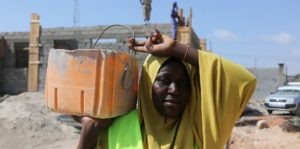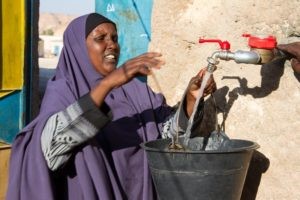


Helping Bring Stability to Somalia
April 12, 2018 | By Zane Kanderian, Director for North America and Europe, Adam Smith International
(Photos by ASI)
How do you stop conflicts in a state that has known little else for several generations? Well, take a critical look at a handful of key parameters that together determine the prospects of peace; identify the trends and the key drivers for progress against each of those parameters; develop interventions that can address constraints that might prevent further progress. Add a multi-donor fund, a secretariat that is highly engaged and a team that responds quickly and effectively. Now you have a way to harness momentum in the right direction.
That is where we are five years after Adam Smith International started managing a fund that started out as a modest, single-source fund designed to continue support to a handful of international NGOs. The Somalia Stability Fund is a multi-donor fund designed to promote peace and state-building in Somalia. Originally set up as the initiative of one donor (the UK Government) in February 2012, the SSF has since attracted support from five additional donors: the Netherlands, Denmark, Sweden, the EU, and KfW, with a total budget of $70m for its first phase (December 2012 to September 2016) and $80m for its second (October 2016 to May 2020).
We take a strategic view every quarter at the state of peace and security, consolidation of the political settlement, international engagement (both positive and negative types), and Social and Economic Development. We then identify trends, opportunities and threats and then work co-operatively with the donors to find strategic areas where we need to concentrate investment in response.
Together, we have stopped over 500 small conflicts breaking out, built dozens of government assets that have the support of local communities and almost 100 projects and many more sub-projects that reduce tensions, encourage co-operation and address resource shortfalls that might otherwise lead to conflict.
At the end of its first phase in October 2016, the SSF had:
- Provided technical assistance and logistics support to the State Formation processes in South West, Galmudug, and Hirshabelle leading to the establishment of the respective Federal Member States
- Supported 1,168 governance structures through capacity building, training, or investment support, including 6 Federal Government of Somalia Ministries, 23 Federal Member State institutions, 97 district institutions and 1025 community structures
- Delivered stabilization interventions in 8 stabilization districts including Bardheere, Berdale, Wajid and Xudur. None of the stabilization districts SSF has invested in have reverted to Al-Shabaab
- Trained 930 Government officials (147 of which were women) in performing functions of government including training of Caretaker Administrators and our flagship support the establishing the Ministries of Finance and Civil Service Commissions in Jubbaland, South West, and Galmudug
- Involved or consulted 20,248 people directly in decision-making on policies and investments
- Renovated or constructed 846 public facilities including police stations, court houses, government administration buildings, and irrigation and flood defense systems
- Supported the peaceful management of 485 conflicts ranging from localized revenge killings and conflict over resources to inter-district conflicts over water
- Trained 7,606 people (3,226 of which were women) in conflict resolution and mediation skills including community elders and religious leaders who are applying those skills
- Created education, vocational training or economic opportunities for 14,761 youth (of which 6,737 were women) through short-term job creation in employment-intensive works and longer-term placements through its pilot job placement service for Somali female university graduates.
Phase II started with new projects in the past few months, and the Fund has consolidated its portfolio into four components: 1) Stabilization, 2) State-building (Institutions), 3) Conflict Prevention; and 4) Mitigation. To date:
- Stabilization:
a. A total of 303 people (or which 104 are women) have been employed for short-term labor-intensive works to construct small community facilities in Bardhere.
- State-building:
a. A total of 729 people (of which 102 are women) have been employed for short-term labor-intensive works to construct a multipurpose government ministry complex and a youth centre in Kismayo.
b. A total of 8 public assets were constructed or rehabilitated during this period, including The Ministry of Finance and State Ministry of the Presidency in Baidoa, the District commissioner’s offices, guesthouses, basketball courts, vegetable, fruit and meat markets and a Mother-Child Health facility in Mahaday and Adaale.
c. A total of 130 people (72 of which are women) were engaged in community consultations to determine community priorities in Bardhere.
- Conflict Prevention & Management:
a. A total of 821 people (103 of which are women) benefited from short-term employment and unconditional cash transfer schemes implemented by the Fund in Sool, Sanaag and Bari regions in response to the 2017 drought.
While the constraints and the conflict still persist, these results are gradually building for many what peace and the future might look like.